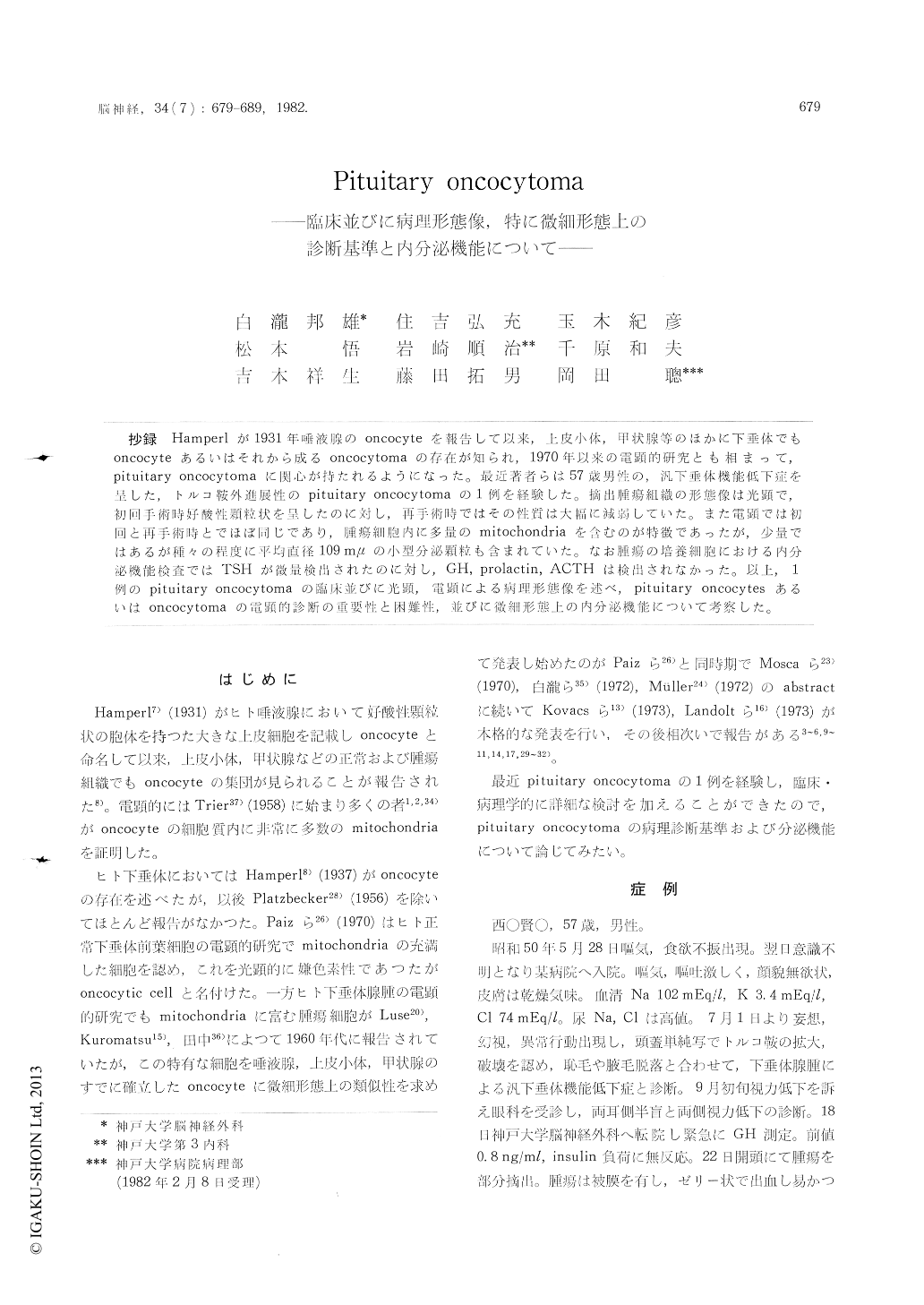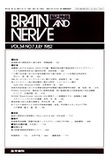Japanese
English
- 有料閲覧
- Abstract 文献概要
- 1ページ目 Look Inside
抄録 Hamperlが1931年上唾液腺のoncocyteを報告して以来,上皮小体,甲状腺等のほかに下垂体でもoncocyteあるいはそれから成るoncocytomaの存在が知られ,1970年以来の電顕的研究とも相まって,pituitary oncocytomaに関心が持たれるようになった。最近著者らは57歳男性の,汎下垂体機能低下症を呈した,トルコ鞍外進展性のpituitary oncocytomaの1例を経験した。摘出腫瘍組織の形態像は光顕で,初回手術時好酸性顆粒状を呈したのに対し,再手術時ではその性質は大幅に減弱していた。また電顕では初回時と再手術時とでほぼ同じであり,腫瘍細胞内に多量のmitochondriaを含むのが特徴であったが,少量ではあるが種々の程度に平均直径109mμの小型分泌顆粒も含まれていた。なお腫瘍の培養細胞における内分泌機能検査ではTSHが微量検出されたのに対し,GH,prolactin,ACTHは検出されなかった。以上,1例のpituitary oncocytomaの臨床並びに光顕,電顕による病理形態像を述べ,pituitary oncocytesあるいはoncocytomaの電顕的診断の重要性と困難性,並びに微細形態上の内分泌機能について考察した。
Hamperl (1931), for the first time, proposed the term "oncocyte " for a large epithelial cell with extreme cytoplasmic granularity and acidophilia in human salivary glands. Thereafter oncocytes or oncocytoma composed of oncocytes have been found also in thyroid, parathyroid, pancreas, etc.. Electron microscopy has shown that oncocytes contain ex-cessive accumulations of mitochondria since 1959. In anterior lobe of the hypophysis, Hamperl (1936) also described oncocytes, but the regular light and electron microscopical study on pituitary oncocy-toma has been started far later since about 1970. Although several pituitary oncocytomas have been reported in these years, many problems still remain unanswered.
As we experienced an attractive case of pituitary oncocytoma recently, we dscribed his clinical course and, light and electron microscopical findings of the tumor, and, in particular, discussed the pathologi-cal criteria for pituitary oncocytoma and its hormonal function.
A 57-year-old man was admitted on May 28, 1975, because of nausea, loss of appetite and faint-ing. On investigation, serum Na value was 102 mEq/1, K 3. 4 mEq/l, Cl 74 mEq/l, on the contrary urinary Na and CI high. His axillary and pubic hair were scant. About a month later he had delirium and abnormal behavior, and further 2 months later he complained bilateral failing vision. Plain skull X-ray revealed the cellar enlargement and destruction. With the diagnosis of non-func-tioning pituitary adenoma. operation was performed on September 22. The solid, jellied mass was partially extirpated. In April, 1979, he was read-mitted because of persistency of a large mass with supra- and parasellar extension, confirmed by CT. Hormonal examination showed that GH, prolactin and ACTH had no responses to various test stimuli as well as they were very low levels in baseline, on the other hand, LH, FSH and TSH responded normally or to some extent as well as their basal values were normal or somewhat lower. On June 18, the patient had reoperation, accompanied by irradiation therapy with the total doses of 4,000 rads.
Light microscopy of the tissue removed during first operation demonstrated the tumor composed of granular eosinophilic cells with organoid arrange-ment. But the granularity and eosinophilia was diminished in the tumor from second operation.
Electron microscopically, the findings between specimens from the first and second operation were thought to be almost the same. The striking feature was the presence of a great many mitochon-dria in most tumor cells. Most mitochondria were normal, but some were condensed or swollen. A few secretory granules with an average diameter of 109 nm were also noted.
Accordingly, it is concluded that numerous mitochondria cause the oncocytic granularity of cytoplasm observed by light microscopy. We agree to the thought that pituitary oncocytoma should be correctly identified after they had been studiedby electron microscopy. Pituitary oncoytoma derived from common pituitary adenoma, aside from oncocytoma only composed of fully developed oncocytes without secretory granules. Although it is difficult to define precisely the pituitary ade-noma which is composed predominantly of transi-tional oncocytes ultrastructurally, such a tumor is also thought to be a type of pituitary oncocytoma.

Copyright © 1982, Igaku-Shoin Ltd. All rights reserved.


